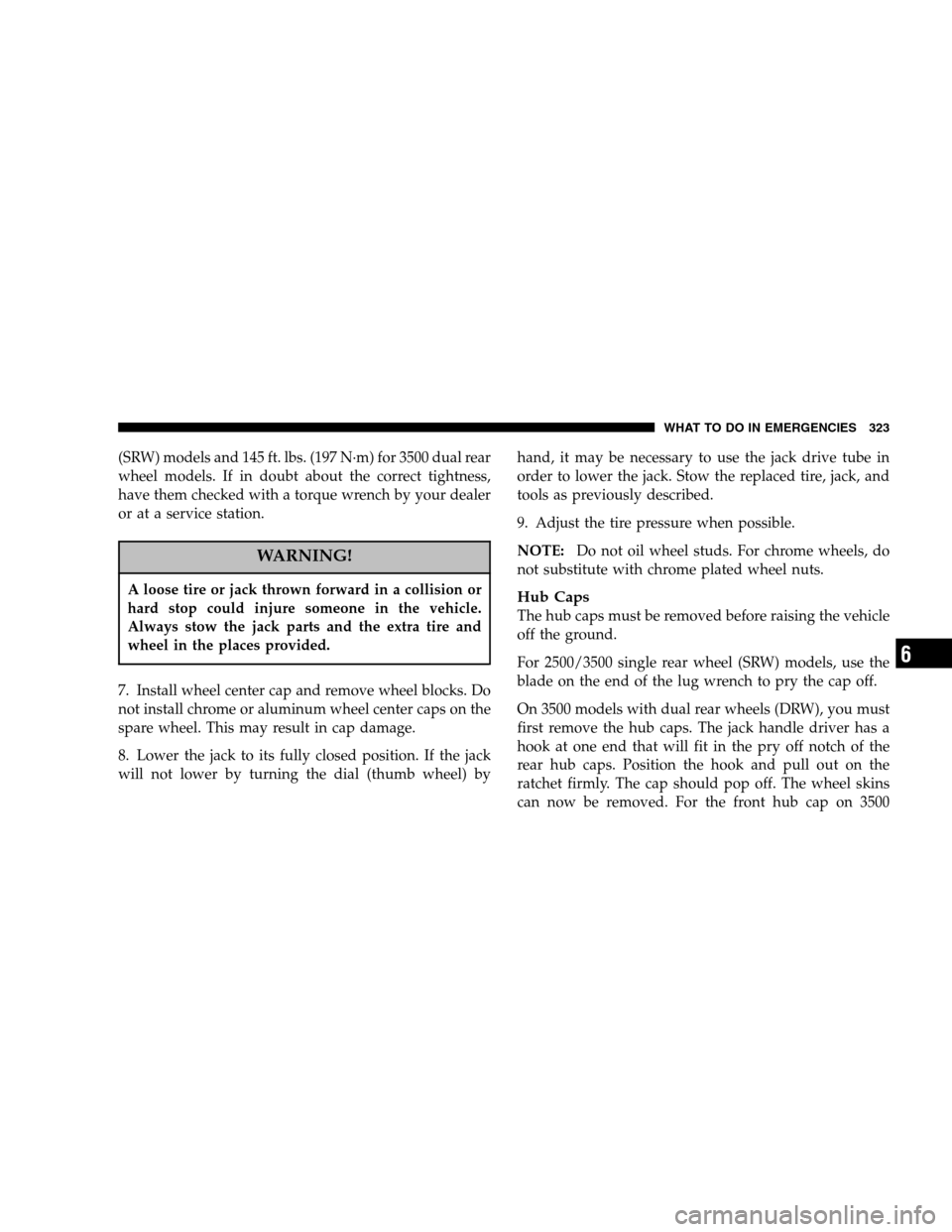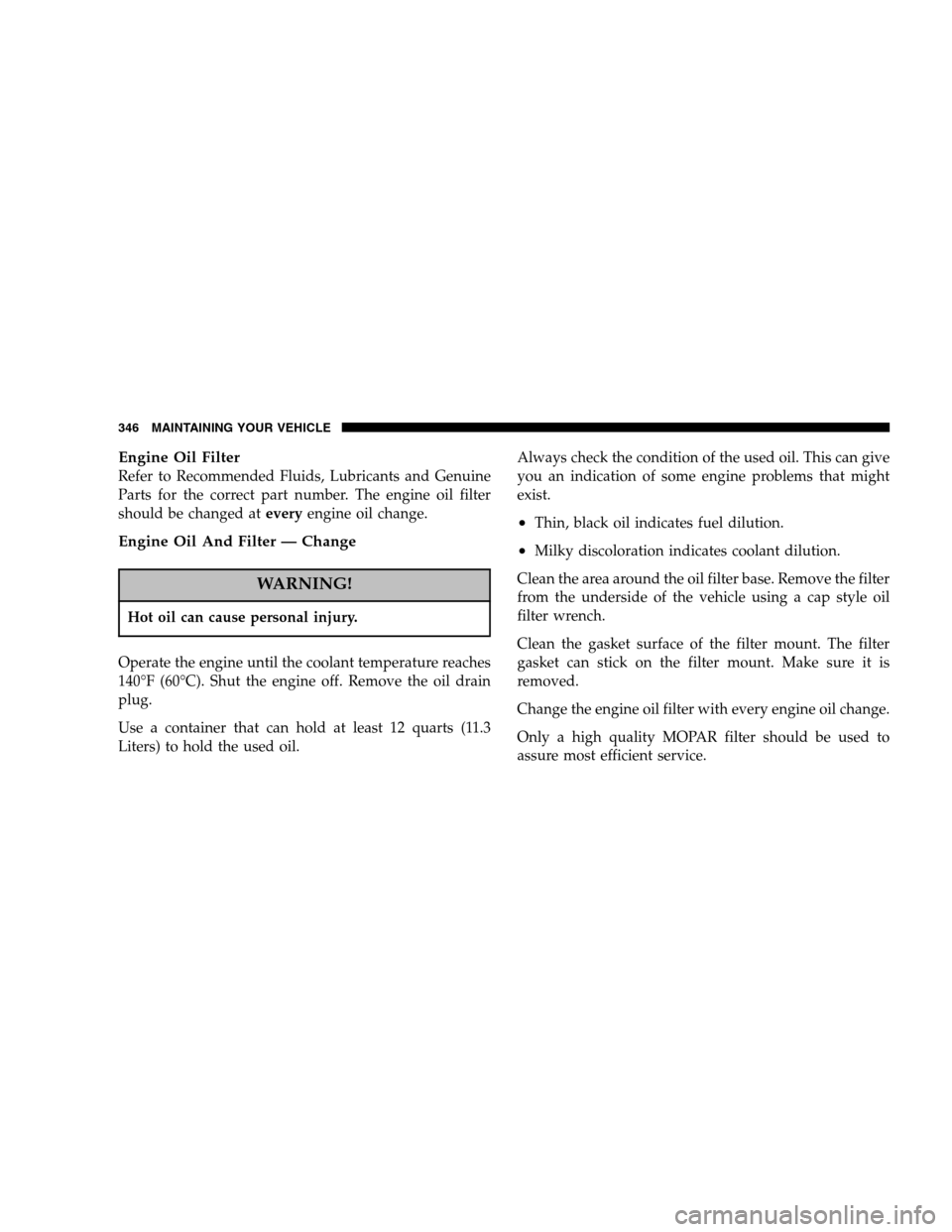Page 323 of 448

(SRW) models and 145 ft. lbs. (197 N·m) for 3500 dual rear
wheel models. If in doubt about the correct tightness,
have them checked with a torque wrench by your dealer
or at a service station.
WARNING!
A loose tire or jack thrown forward in a collision or
hard stop could injure someone in the vehicle.
Always stow the jack parts and the extra tire and
wheel in the places provided.
7. Install wheel center cap and remove wheel blocks. Do
not install chrome or aluminum wheel center caps on the
spare wheel. This may result in cap damage.
8. Lower the jack to its fully closed position. If the jack
will not lower by turning the dial (thumb wheel) byhand, it may be necessary to use the jack drive tube in
order to lower the jack. Stow the replaced tire, jack, and
tools as previously described.
9. Adjust the tire pressure when possible.
NOTE:Do not oil wheel studs. For chrome wheels, do
not substitute with chrome plated wheel nuts.
Hub Caps
The hub caps must be removed before raising the vehicle
off the ground.
For 2500/3500 single rear wheel (SRW) models, use the
blade on the end of the lug wrench to pry the cap off.
On 3500 models with dual rear wheels (DRW), you must
first remove the hub caps. The jack handle driver has a
hook at one end that will fit in the pry off notch of the
rear hub caps. Position the hook and pull out on the
ratchet firmly. The cap should pop off. The wheel skins
can now be removed. For the front hub cap on 3500
WHAT TO DO IN EMERGENCIES 323
6
Page 335 of 448
MAINTAINING YOUR VEHICLE
CONTENTS
�Engine Compartment....................338
▫5.9L HO Cummins Turbo Diesel...........338
�Onboard Diagnostic System (OBD II).........339
�Replacement Parts......................339
�Dealer Service.........................340
�Service Information.....................340
�Maintenance Procedures..................343
▫Engine Oil..........................343
▫Drive Belt...........................348▫Engine Air Cleaner Filter................349
▫Draining Fuel/Water Separator Filter.......351
▫Maintenance Free Batteries...............354
▫Air Conditioner Maintenance.............355
▫Power Steering — Fluid Check............356
▫Front Suspension Ball Joints..............357
▫Steering Linkage — Inspection............357
▫Front Prop Shaft Lubrication.............358
7
Page 342 of 448

•If an engine has been operating and the coolant is hot,
allow the engine to cool before you slowly loosen the
filler cap and relieve the pressure from the cooling
system.
•To avoid burns, remember that the engine components
will stay hot after the engine is shut off.
•Do not use gasoline or other flammable materials to
clean parts. Always use approved cleaning solvents.
•Relieve all pressure in the fuel, oil and cooling systems
before any lines, fittings or related items are removed
or disconnected. Be alert for possible pressure when
disconnecting any device from a system that utilizes
pressure. Do not check for pressure leaks with your
hand. High pressure oil or fuel can cause personal
injury.
WARNING!
Do not open the high pressure fuel system with the
engine running. Engine operation causes high fuel
pressure. High pressure fuel spray can cause serious
injury or death.
•Important:All maintenance other than that listed in
this manual, as well as some procedures listed here,
MUSTbe performed by your local Dodge Truck
Dealer. Your authorized Dodge Dealer has been
trained and has the necessary parts to maintain your
engine.
342 MAINTAINING YOUR VEHICLE
Page 343 of 448

MAINTENANCE PROCEDURES
The pages that follow contain therequiredmaintenance
services determined by the engineers who designed your
vehicle.
Besides the maintenance items for which there are fixed
maintenance intervals, there are other items that should
operate satisfactorily without periodic maintenance.
However, if a malfunction of these items does occur, it
could adversely affect the engine or vehicle performance.
These items should be inspected if a malfunction is
observed or suspected.
Engine Oil
Checking Oil Level
To assure proper lubrication of your vehicle’s engine, the
engine oil must be maintained at the correct level. Check
the oil level at regular intervals. The best time to check
the oil level is before starting the engine after it has been
parked overnight. When checking oil after operating theengine, first ensure the engine is at full operating tem-
perature, then wait at least 15 minutes after engine
shutdown to check the oil.
Checking the vehicle while it’s on level ground will also
improve the accuracy of the oil level readings. Add oil
only when the level on the dipstick is below the “ADD”
mark. The total capacity from the low mark to the high
mark is 2 quarts (1.9 liters).
MAINTAINING YOUR VEHICLE 343
7
Page 344 of 448

Never operate the engine with oil level below the “ADD”
mark or above the upper “SAFE” mark.
Change Engine Oil
CAUTION!
Overfilling or underfilling the crankcase will cause
oil aeration or loss of oil pressure. This could dam-
age your engine.
Road conditions as well as your kind of driving affect the
interval at which your oil should be changed. Check the
following to determine if any apply to you:
•Frequent short trips where the engine does not achieve
full operating temperature (operating temperature de-
fined as 190° F (66° C) coolant temperature).
•Extensive engine idling (over 10 minutes per hour of
operation) at ambient temperatures less than 32° F (0°
C).
•Driving in dusty conditions.
•Frequent trailer towing.
•Taxi, police, or delivery service (commercial service).
•Off-road or desert operation.
•Extensive operation at high engine speeds (greater
than 2900 rpm) and loads (greater than 70% throttle).
IfANYof these apply to you, then change your engine oil
at every interval shown in schedule�B�of the�Mainte-
nance Schedules�section of this manual.
If none of these apply to you, then change your engine oil
at every interval shown on schedule�A�of the�Mainte-
nance Schedules�section of this manual.
344 MAINTAINING YOUR VEHICLE
Page 346 of 448

Engine Oil Filter
Refer to Recommended Fluids, Lubricants and Genuine
Parts for the correct part number. The engine oil filter
should be changed ateveryengine oil change.
Engine Oil And Filter — Change
WARNING!
Hot oil can cause personal injury.
Operate the engine until the coolant temperature reaches
140°F (60°C). Shut the engine off. Remove the oil drain
plug.
Use a container that can hold at least 12 quarts (11.3
Liters) to hold the used oil.Always check the condition of the used oil. This can give
you an indication of some engine problems that might
exist.
•Thin, black oil indicates fuel dilution.
•Milky discoloration indicates coolant dilution.
Clean the area around the oil filter base. Remove the filter
from the underside of the vehicle using a cap style oil
filter wrench.
Clean the gasket surface of the filter mount. The filter
gasket can stick on the filter mount. Make sure it is
removed.
Change the engine oil filter with every engine oil change.
Only a high quality MOPAR filter should be used to
assure most efficient service.
346 MAINTAINING YOUR VEHICLE
Page 347 of 448

CAUTION!
The filtering medium of other aftermarket filters
may disintegrate. Debris from failed filters may plug
the piston oil cooling nozzles, resulting in scuffed
pistons and engine failure.
CAUTION!
Fill the oil filter element with clean oil before
installation. Use the same type oil that will be used
in the engine. When filling the oil filter, prevent
foreign material from falling into the filter. Severe
engine damage may occur.
Apply a light film of lubricating oil to the sealing surface
of the filter gasket before installing the filter.
CAUTION!
Overtightening may distort the threads or damage
the filter element seal.
Install the filter as specified by the filter manufacturer.
Turn the filter 3/4 to one full turn after making contact
with the gasket.
Check the condition of the threads and sealing surface on
the oil pan and drain plug.
Install the drain plug and sealing washer and tighten to
37 ft-lbs. (50 N·m).
Use only high-quality multi-grade lubricating oil in your
Cummins Diesel Engine. Choose the correct oil for your
operating conditions as outlined in the Selection of
Engine Oil.
MAINTAINING YOUR VEHICLE 347
7
Page 348 of 448

Cummins Turbo Diesel
Fill the engine with the correct grade of new oil. The
engine capacity is 11 quarts (10.4 liters) in the crankcase
and 1 quart (.95 liter) in the lubricating oil filter.
Start the engine and operate it at idle for several minutes.
Check for leaks at the lubricating oil filter and oil pan
drain plug.
Run the engine until it has reached operating tempera-
ture, stop the engine. Wait approximately 15 minutes to
let the oil in the upper parts of the engine drain back to
the pan. Check the oil level again.
Add oil as necessary to bring the level to the “SAFE”
mark on the dipstick.
Disposing Of Used Engine Oil And Filter
Care should be taken in disposing of the used engine
fluids from your vehicle. Used fluids, indiscriminately
discarded, can present a problem to the environment.Contact your local dealer, service station, or governmen-
tal agency for advice on recycling programs and where
used fluids and filters can be safely discarded in your
area.
Drive Belt
Inspection
Check the belt for intersecting cracks.
•Transverse (across the belt width) cracks are accept-
able.
•Longitudinal (direction of belt length) cracks that
intersect with transverse cracks are NOT acceptable.
Replace the belt if it has unacceptable cracks, is frayed or
has pieces of material missing.
The engine speed sensor, located near the damper, should
be inspected for damage if a belt is frayed.
348 MAINTAINING YOUR VEHICLE